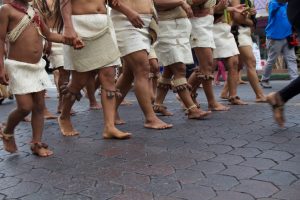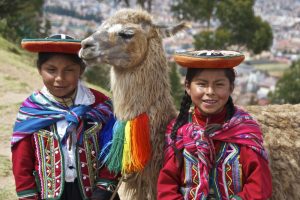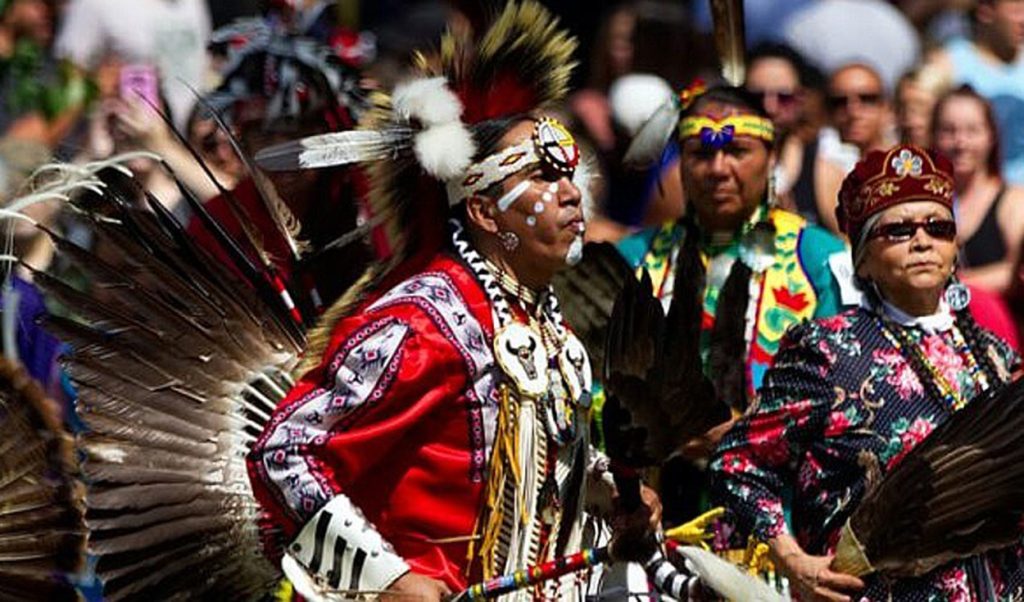We crossed the trickling Buenavista river and followed a dirt path through ceibo and carob trees, past bulbous termite nests and women beating laundry against the rocks, until we emerged at a clearing beneath a twisted ficus. Shaman Plinio Merchán was waiting for us. His body was painted with russet-colored achiote ink and a precious ceramic necklace, generations old, hung over his heart.
Merchán is the leader of Agua Blanca, an Indigenous community descended from the Manteño, one of the oldest civilizations in South America. For 1,500 years, ancestral knowledge has been passed from father to son. But today—for the first time ever—Merchán has invited outsiders to join him in ritualistic prayer.
A trail of sawdust forms serpentine lines in the dirt, and it is along this path that we walk barefoot. A pyre burns at the center of the circle and the air is perfumed with smoking palo santo. Merchán tells us to make a wish before calling out to the solstices and directional winds, blessing families and nations near and far, and ending the ceremony with the mournful wail of a conch shell. This was not how I pictured life on a superyacht. It’s better.
The gleaming, 128-foot M/Y Kontiki Wayra has nine staterooms, a spa, jacuzzi, wine cellar, and sundeck for sipping juice from freshly hacked coconuts. The trip I’ve joined begins and ends in Manta, a bustling fishing port in Ecuador’s central Manabí province. The flora and fauna in this region is not unlike what you’d find in the Galápagos. The big difference: no tourist ships.Carlos Nuñez, whose family made its fortune in tuna fishing, started Kontiki Expeditions because he wanted to bring sustainable tourism to the seldom-visited coast of mainland Ecuador. By focusing on boutique yacht excursions, Nuñez keeps his environmental footprint small while creating jobs and supporting communities still recovering from 2016’s devastating 7.8-magnitude earthquake. His idea was so novel, Nuñez had to offer 20 to 30 percent higher wages to convince the deck crew to take a gamble on his vision.

Every stop on my itinerary serves this greater mission. When our plancha rolled up to Gray Bay at Isla de la Plata, we were the only people there. The island is part of Machalilla National Park, the largest in Ecuador. It’s nicknamed “Little Galapagos,” or, more derisively, “Galapagos of the Poor,” which drives guide Raul “Ruly” Menoscal mad. “This place deserves respect,” the retired shortstop turned passionate naturalist growls, noting that while there is some overlap in wildlife between the famous volcanic archipelago and here, this is one of the world’s finest sea bird reserves. “It just suffers from lousy marketing.”
Isla de la Plata has a cap of 200 visitors per day in the high season, but Nuñez pulled enough strings to ensure we had the place mostly to ourselves. Park ranger Sandra Plua led us on a three-mile hike through seabird nesting grounds, pointing out medicinal plants along the way: sticky glueberries, or muyuyo, are a natural laxative and sunscreen; mimosa albida, recognizable by its frilly fuschia pom poms, is boiled for tea and used to treat menstrual cramps. Nazca boobies with traffic cone-orange beaks tottered along jagged cliffs and magnificent frigates swooped overhead, but I was particularly fixated on a jilted blue-footed boobie staring longingly at the lady he lost and her new male suitor.
While the snorkeling at Isla de la Plata cannot compare with the Galápagos (the currents are choppier and the Pacific green sea turtles few and far between), I enjoyed playing with the yacht’s toys in between port calls: kayaks, Seabobs, and a three-story inflatable slide that elicits high-pitched squeals from anyone brave enough to whoosh down it.
Another afternoon we traveled inland to Finca el Perezoso (“Lazy Farm”), zipping past miles of shrimp farms en route. Permaculture devotee Servio Pachard grows 105 varieties of fruit on the same land his great grandfather worked. He led us through the greenery, snaking around dragonfruit and cherimoya trees, plucking cherries from his coffee bushes as he strolled, and finally arriving at his treasured cacao trees—survivors of two El Niños, a flood, and a fungal epidemic that nearly wiped out Ecuador’s chocolate industry a century ago. The 140- to 150-year-old trees are so rare, in fact, Pachard had their DNA analyzed just to prove they existed. The single-origin chocolate bars made from his heirloom pods fetch upward of $400 for 50 grams, so I settle for a bowl of fresh fruit drizzled with chocolate Pachard has just roasted over an open flame and cranked through a hand grinder. It is rich beyond imagination and, taken with a pinch of flaky salt and fresh chili, completely sublime.

Then there was the languorous five-course lunch at Iche, a restaurant, cooking school, and fermentation lab in San Vincente. Iche is training provincial chefs to marry the foodways of their ancestors with the kind of innovative culinary techniques that wow World’s 50 Best diners. After marveling over a citrusy snapper carpaccio with peanut ice cream, I joined chef Valentina Álvarez for a Manabíta oven tutorial. The ash-heated vessel cooks everything from tortillas to pig heads. It’s also, Álvarez says with a wink, “where we share traditions, legends, [and] secrets.”
On our last day in Manabí, we head to Pacoche Coastal Marine and Wildlife Refuge, a 32,000-acre tropical preserve thick with towering bamboo and wild bromeliads. Guide Carlos Alvia’s enthusiasm is infectious. When he isn’t woofing at howler monkeys high in the trees, he fishes hairy tarantulas out of their hidey holes and cradles tree frogs smaller than a pinkie tip. At one point he paused to fawn over the elegant toquilla palm whose sturdy fronds are dried, ribboned, and woven into the finest straw hats on earth.
I see this artistry firsthand in nearby Pile, a community known for its abundance of Panama hat makers. Fifth-generation master weaver Hólger Domingo Carranza is hunched over a stool, fingers tangoing across the brim of a partially finished hat. My back aches just looking at him, but Carranza spends eight to 10 hours a day in this gnarled position. Carranza’s hats belong behind museum glass. The tightest weaves, which brokers commission up to a year in advance, can pull six figures at an international auction, but Carranza makes just a few thousand dollars per sale. Pile doesn’t even have a souvenir shop.
In a way, I wonder if Manabí is ready for primetime. Some of its piers are crumbling or non-existent and wizened fishermen stare gape-jawed every time a Zodiac belches up a gaggle of life-jacketed tourists. The artisans haven’t figured out how best to monetize their craft. And yet, Nuñez notes, every place now considered a destination was “nothing before it was something.” It just takes one person to see the potential and strike a match.
